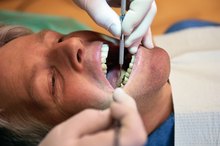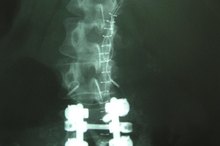Side Effects of Occlusal Splint Therapy
An occlusal splint, also known as a bite guard, is a removable dental device. It is commonly used to treat temporomandibular disorders, which are characterized by problems with the mechanisms of your jaw. These problems can cause pain and problems chewing. Occlusal splints are designed to stabilize your jaw in order to restore proper jaw movement. Occlusal splints may have side effects and should only be worn under the supervision of your dentist.
Mandibular Displacement
Occlusal splints, worn on a part-time basis for four to six weeks, have little side effects, according to Irwin M. Becker, author of "Comprehensive Occlusal Concepts in Clinical Practice." However, wearing an occlusal splint for longer than 6 weeks can negatively impact your mandibular condyle joint, causing complications in your bite, explains Becker 1. This joint is located just under your ear and allows your mouth to open and close.
Unstable Occlusion
Dental Bridge Complications
Learn More
Case reports published in the April 2010 issue of "The Journal of Craniomandibular Practice," indicate that wearing an occlusal splint long-term can cause unstable occlusion. This refers to the way your upper and lower teeth align when you close your mouth. The case report notes that the patient wore an occlusal splint for six months at the recommendation of his orthodontist, which lead to an unstable occlusion at the level of his wisdom teeth.
Facial Pain
Facial pain is a side effect of an improperly fitted occlusal splint, according to Becker. It is important to have your occlusal splint fitted properly and re-adjusted as needed, Becker explains. Contact your orthodontist if you experience relief from your symptoms initially, but experience a return of symptoms or new symptoms, such as facial pain. Your orthodontist can make adjustments in your occlusal splint to make sure that it fits properly throughout your treatment.
- Facial pain is a side effect of an improperly fitted occlusal splint, according to Becker.
- Your orthodontist can make adjustments in your occlusal splint to make sure that it fits properly throughout your treatment.
Considerations
Cons of Wearing an Occlusal Splint
Learn More
Occlusal splints are meant to improve your jaw function if you have a temporomandibular disorder, or protect your teeth from grinding. Data suggests that wearing an occlusal splint part-time for up to six weeks decreases your risk of side effects. Discuss the possible side effects with your orthodontist if an occlusal splint is recommended for longer than six weeks.
- Occlusal splints are meant to improve your jaw function if you have a temporomandibular disorder, or protect your teeth from grinding.
- Discuss the possible side effects with your orthodontist if an occlusal splint is recommended for longer than six weeks.
Related Articles
References
- Comprehensive Occlusal Concepts in Clinical Practice; Irwin M. Becker
Writer Bio
Janet Renee is a clinical dietitian with a special interest in weight management, sports dietetics, medical nutrition therapy and diet trends. She earned her Master of Science in nutrition from the University of Chicago and has contributed to health and wellness magazines, including Prevention, Self, Shape and Cooking Light.








